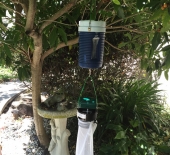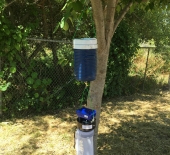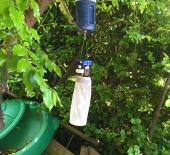Regular surveillance of both immature and adult mosquitoes is important because it provides us with information that is crucial to an effective control program. Surveillance programs determine where, when, how many, and which species of mosquito are likely to be encountered.
Routine larval surveillance is accomplished with a dipper and a plastic cup attached to the end of a thin pole. Larval breeding areas are sampled by dipping the cup into the water and inspecting it for mosquito larvae. Inspections are performed on several types of sources, including marshes, ditches, creeks, canals, catch basins, neglected fish ponds or hot tubs.
For adult mosquitoes, a specialized trap called an EVS (encephalitis vector surveillance) trap is usually used. These battery powered devices use dry ice (frozen carbon dioxide) as an attractant, and operate a fan that collects live adult mosquitoes into a bag. Each location is usually trapped every two weeks, from March through October. The most commonly encountered mosquito species in Albany where we used to perform surveillance were Culiseta incidens, Culex tarsalis, and Culex pipiens.
Most Districts participate with other State mosquito and vector control districts in implementing a surveillance program for two invasive (nonnative) mosquitoes, Aedes aegypti and Aedes albopictus. Because of their unique behavior, these two species require specialized traps, which are strategically placed. These traps either collect the live eggs produced by an adult, or trap a water-seeking adult onto a sticky band.
Mosquito control is accomplished using an integrated approach. This means that least toxic methods are always utilized first. When appropriate, education of home owners and the dumping and draining of stagnant water are employed. For back yard fish ponds, mosquito fish (
Gambusia affinis) may help to control larval mosquitoes.
For those sources that require a treatment, products that specifically target the mosquito biology in the immature stages are used. These are naturally-based substances and have minimal environmental impact. One group is derived from a type of bacteria called Bacillus, and include Bacillus thuringensis israelensis and Bacillus sphaericus. These materials act as stomach poisons on feeding larvae. Another type of product that may be used is an insect growth regulator, called methoprene. This mimics a specific mosquito hormone and prevents the pupating mosquito from emerging as a normal functional adult. Methoprene is absorbed directly into the body of the mosquito, and must be applied during the correct larval stage in order to be effective. Any of these materials may be applied in a liquid, granular, or “briquette” form.






